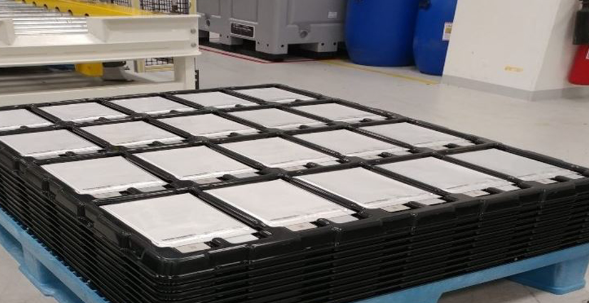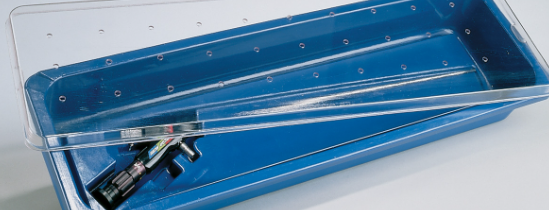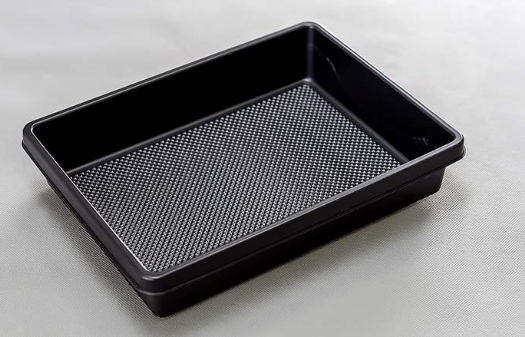Vacuum formed custom trays typically use materials like PET, polycarbonate, and acrylic for their durability and versatility.

Materials Used in Vacuum Forming
Vacuum forming is a versatile process in manufacturing where sheets of plastic are heated to a pliable forming temperature, then formed over a mold with the help of a vacuum. This process is widely used due to its efficiency and cost-effectiveness in producing items ranging from packaging materials to components in various industries.
Polyethylene Terephthalate (PET)
- Properties and Applications
- PET is a clear, strong, and lightweight plastic belonging to the polyester family. It’s often used in vacuum forming due to its high strength-to-weight ratio.
- In applications, PET is popular in food and beverage packaging, especially for making bottles, because of its excellent barrier properties against water vapor and gases. It’s also common in medical device packaging due to its clarity and sterilizability.
- This material is also recyclable, which adds to its appeal in environmentally-conscious applications.
- Advantages for Custom Trays
- PET’s versatility allows for the production of custom trays that are durable and resistant to impact. This makes them ideal for protective packaging solutions.
- Its clarity ensures that contents are easily visible, an essential feature for presentation and inspection purposes.
- PET trays can withstand a wide range of temperatures, making them suitable for various storage and transport conditions.
Acrylic
- Characteristics and Benefits
- Acrylic, known for its clarity and resemblance to glass, is another popular choice for vacuum forming. It’s more shatter-resistant compared to glass, making it safer for use in high-risk environments.
- Acrylic sheets can easily be colored or tinted, offering aesthetic flexibility for designers.
- The material has excellent weather resistance, maintaining its clarity and mechanical properties over time even when exposed to sunlight and outdoor elements.
- Limitations in Use
- Acrylic can be more expensive than other plastics, impacting the budget of a project.
- It’s more prone to scratching compared to other harder plastics, which can be a disadvantage in applications where surface aesthetics are crucial.
- The material’s thermal expansion can be a factor to consider in applications involving temperature fluctuations.
Comparative Analysis of Materials
In vacuum forming, the selection of the right material is critical for achieving desired performance, cost-efficiency, and product longevity. Different materials offer varying levels of strength, durability, temperature resistance, and biocompatibility. This comparative analysis aims to provide a detailed insight into these factors.
Strength and Durability Considerations
- Polyethylene Terephthalate (PET)
- PET exhibits high tensile strength, making it resistant to physical impacts and suitable for heavy-duty applications.
- It has good wear resistance, ensuring longevity even in high-use scenarios.
- Acrylic
- Acrylic stands out for its exceptional clarity and glass-like aesthetics but is less durable compared to PET. It is prone to scratching and cracking under high impact.
- It provides good resistance against UV degradation, maintaining its appearance over time.
- Polycarbonate
- Polycarbonate is renowned for its high impact strength, often used in applications requiring robustness, such as in protective gear.
- It has a higher resistance to cracking and breaking, making it ideal for long-term use in demanding environments.
Temperature Resistance and Biocompatibility
- Polyethylene Terephthalate (PET)
- PET maintains its properties in temperatures ranging from -40°C to 70°C, suitable for a variety of environments.
- It is generally considered biocompatible for food contact and medical applications.
- Acrylic
- Acrylic performs well in a temperature range of -30°C to 70°C but can warp at higher temperatures.
- While it is safe for general use, it’s not typically used in medical implants due to its limited biocompatibility.
- Polycarbonate
- Polycarbonate excels in high-temperature environments, withstanding temperatures up to 120°C.
- It is often used in medical devices due to its excellent biocompatibility.
Cost-Effectiveness and Availability
- Polyethylene Terephthalate (PET)
- PET is widely available and generally more cost-effective compared to other high-performance plastics.
- Its recyclability also adds to cost savings in long-term applications.
- Acrylic
- Acrylic is moderately priced but can be more costly than PET, especially for high-quality grades.
- It is readily available in various grades and forms, allowing flexibility in design and use.
- Polycarbonate
- Polycarbonate is typically more expensive than both PET and Acrylic, reflecting its superior strength and thermal properties.
- It is widely available but might increase the overall cost of the project due to its higher price point.

Manufacturing Process of Custom Trays
The manufacturing process of custom trays involves several steps, each crucial to ensure the final product meets the required specifications and quality standards. This process typically utilizes materials like PET, acrylic, or polycarbonate, depending on the application’s requirements.
Step-by-Step Procedure
- Design and Prototyping
- Initially, create a detailed design of the tray based on the client’s specifications. This design includes dimensions, shape, and any specific features required.
- Utilize computer-aided design (CAD) software to model the tray and develop a prototype. This step is vital for visualizing the final product and making necessary adjustments before mass production.
- Material Selection
- Choose the appropriate material based on factors like strength, temperature resistance, and cost. The selection plays a critical role in the tray’s performance and longevity.
- Sheet Preparation
- Cut the chosen material into sheets of required size. Precision in this step ensures minimal waste and consistency in the final products.
- Heating
- Heat the plastic sheets to the appropriate temperature where they become pliable. The heating temperature varies depending on the material; for instance, PET requires a different temperature range compared to acrylic.
- Forming
- Place the heated sheet over the mold designed for the tray. Apply a vacuum to draw the sheet into the mold, ensuring it takes the exact shape of the mold.
- Cooling and Releasing
- Cool the formed material to set its shape. Once cooled, remove the formed tray from the mold.
- Trimming and Finishing
- Trim any excess material and perform necessary finishing touches. This step may include smoothing edges or adding additional features as per the design.
- Inspection and Packaging
- Conduct a thorough inspection of each tray to ensure quality and consistency. Package the trays for delivery or further processing as required.
Quality Control and Standardization
- Inspection Protocols
- Implement strict inspection protocols at each stage of the manufacturing process. These protocols include checking the dimensions, material consistency, and overall quality of the trays.
- Adherence to Standards
- Ensure the manufacturing process adheres to relevant industry standards, such as ISO standards for quality management and product specifications. This adherence guarantees that the trays meet both regulatory and client requirements.
- Continuous Monitoring
- Engage in continuous monitoring and assessment of the process to identify any potential issues early. This approach includes regular equipment checks, material quality assessments, and feedback reviews.
- Testing for Durability and Performance
- Conduct tests on the trays to ensure they meet the durability and performance criteria. This testing might include stress tests, temperature resistance tests, and load-bearing capacity assessments.

Applications of Vacuum Formed Trays
Vacuum formed trays find their use in a wide range of industries due to their versatility, durability, and cost-effectiveness. These trays, customized to various shapes and sizes, serve critical roles in medical, dental, industrial, and packaging applications.
Medical and Dental Uses
- Surgical Instrument Trays
- In the medical field, vacuum formed trays provide a sterile and organized way to hold surgical instruments. These trays ensure that instruments remain in place and are easily accessible during procedures.
- The material used, often PET or polycarbonate, can withstand sterilization processes, making them reusable and cost-effective.
- Dental Impression Trays
- Custom trays are vital in dentistry for taking precise dental impressions. They must fit comfortably in a patient’s mouth and accurately capture the dental structure.
- The trays’ material ensures they are rigid enough to hold the impression material without deforming and flexible enough for patient comfort.
- Medical Packaging
- Vacuum formed trays are used for packaging and protecting medical devices and pharmaceutical products. These trays provide a secure fit and protect the contents from damage during transportation and storage.
Industrial and Packaging Applications
- Electronic Component Trays
- In the electronics industry, trays are used for handling and transporting sensitive electronic components. The trays are designed to prevent static discharge that could damage the components.
- Materials like conductive PET are chosen for their antistatic properties, ensuring the safety of electronic parts.
- Food Packaging Trays
- Food industries widely use vacuum formed trays for packaging items like meats, fruits, and ready-to-eat meals. These trays help in maintaining freshness, provide ease of stacking and display, and offer convenience to consumers.
- The trays, often made from PET, are designed to be resistant to oils and fats, and their recyclability aligns with environmental considerations.
- Tool Organizers
- In various industries, custom trays are used for organizing tools and equipment. These trays are designed to hold each tool securely, improving efficiency and reducing the risk of lost or damaged items.
- The strength and durability of materials like polycarbonate make these trays suitable for heavy-duty industrial use.


